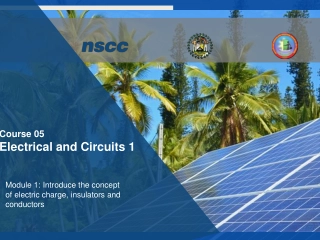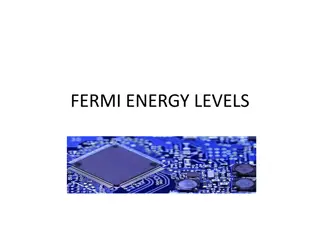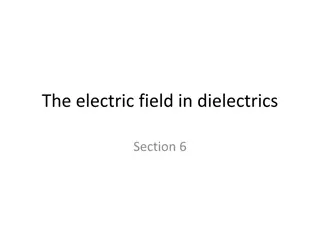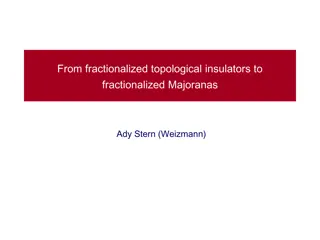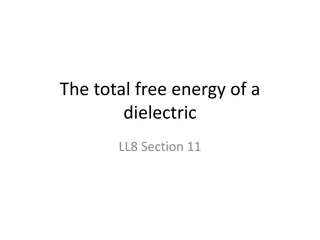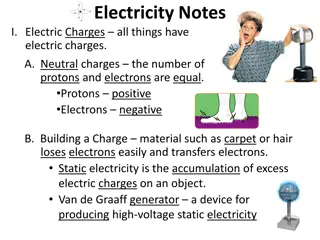Understanding Dielectrics and Insulators in Electrical Engineering
Dielectric materials, also known as insulators, have tightly bound electrons with no free charges, characterized by a forbidden energy band gap of over 4 eV. Insulators, on the other hand, prevent electric current flow due to high resistivity and strong covalent bonds. Learn about the differences, definitions, classifications, and applications of dielectrics and insulators in electrical systems.
Download Presentation

Please find below an Image/Link to download the presentation.
The content on the website is provided AS IS for your information and personal use only. It may not be sold, licensed, or shared on other websites without obtaining consent from the author. Download presentation by click this link. If you encounter any issues during the download, it is possible that the publisher has removed the file from their server.
E N D
Presentation Transcript
Introduction 2 Dielectric materials are also called as insulators. In dielectric materials, all the electrons are tightly bound to their parent molecules and there are no free charges. The forbidden energy band gap (e.g.) for dielectric materials is more than 4 eV. Not possible for the electrons in the valence band to excite to the conduction band, by crossing the energy gap, even with normal voltage or thermal energy. Dielectrics are non-metallic materials of high specific resistance and negative temperature coefficient of resistance
Definition of Dielectric 3 The dielectric material is a type of an insulator which has some free electrons. It becomes polarized in the presence of the electric field. The polarization is the property of the material in which the positive and negative charges of the material are shifted in the opposite direction. The polarization reduces the overall field of the material.
Definition of Insulator 4 The material which does not allow the electric current to pass through them is known as the insulator. The insulating material does not have any free electrons because their molecules have the strong covalent bond. The resistivity of the material is very high as compared with other material. Resistivity is the property of the material that shows the strong obstruction against the flow of charges.
Dielectric and Insulator 5 The dielectric and insulator are differentiated from their applications. One of the major difference between the dielectric and insulator is that the dielectric stores the electrical charges while the insulator opposes the flow of electrons. Some other differences between them are explained below in the comparison chart.
Classification of Dielectrics according to electrical energy store 7 The dielectric materials can be classified into Active dielectric materials Passive dielectric materials.
Active dielectrics 8 When a dielectrics material is kept in an external electric field, if it actively accepts the electricity, then it is shown as active dielectric material .Thus, active dielectrics are the dielectrics which can easily adapt themselves to store the electrical energy in it. Examples:- Piezoelectric materials.
Passive dielectrics 9 Passive dielectrics are the dielectrics which restrict the flow of electrical energy in them. So, these dielectrics act as insulators. Examples: All insulating materials such as glass, mica, rubber.
Classification of Dielectrics according Temperature 10 Dielectric constant, loss tangent and dielectric strength are the three parameters which characterize the dielectric material. Besides, heat resistance is also one of the important properties, on the basis of which dielectrics have been classified:
(i) Class O (Up to 90 C) 11 This category comprises of cotton, silk, paper and similar organic materials when neither impregnated nor immersed in liquid dielectric. (ii) Class A (Up to 105 C) Like the cotton, silk, paper or similar organic materials when either impregnated or immersed in liquid dielectric. This category also includes molded and laminated materials with cellulose filler, phenolic resins.
(iii) Class B (Up to 130 C) 12 Like Mica, asbestos, glass fiber and similar inorganic materials in built-up form with organic binding substances. (iv) Class C (No Temperature Limit) Mica, porcelain, glass, quartz and similar inorganic materials.
Properties of Dielectric Material 13 The energy gap in the dielectric materials is very large. The temperature coefficient of resistance is negative and the insulation resistance is high. The dielectric materials have high resistivity. The attraction between the electrons and the parent nucleus is very strong. The electrical conductivity of these materials is very low as there are no free electrons to carry current.
Important Properties of Dielectric 14 I. Permittivity II. Electric polarization
Permittivity 15 A measure of the ability of a material to interaction with an electrical field and become polarized by the field.
Electric polarization 16 Slight relative shift of positive and negative electric charge in opposite directions with in an insulator, or dielectric, induced by an external electric field.
Dielectric constant 17 The dielectric constant or relative permittivity of a material determines its dielectric characteristics. It is the ratio of the permittivity of the medium and the permittivity of free space as it shown in the following equation:- ? ? = ? / ??
Classification of Dielectrics polarization 18 Polar Molecules. Non-Polar Molecules.
Polar Molecules 19 Polar Molecules are those type of dielectric where the possibilities of the positive and negative molecules coinciding with each other are null or zero. This is because they all are asymmetric in shape. Examples: H2O, When the electric field is not present, it causes the electric dipole moment of these molecules in a random direction. This is why the average dipole moment is zero. If the external electric field is present, the molecules assemble in the same direction as the electric field. CO2, NO2 etc.
Non-Polar Molecule 20 Unlike polar molecules, in non-polar molecules, the center of positive charge and negative coincide, that is it is not zero. The molecule then has no permanent (or intrinsic) dipole moment. Examples: O2, N2, H2.
Applications of Dielectric Material 21 1- These are used for energy storage in capacitors. 2- To enhance the performance of a semiconductor device, high permittivity dielectric materials are used. 3- Dielectrics are used in liquid crystal displays. 4- Ceramic dielectric is used in dielectric resonator oscillator. 5- Barium Strontium Titanate thin films are dielectric which are used in microwave tunable devices providing high tenability and low leakage current.
22 6-In electrical transformers, mineral oils are used as a liquid dielectric and they assist in the cooling process. 7- Castor oil is used in high-voltage capacitors to increase its capacitance value. 8- Electrets, a specially processed dielectric material acts as electrostatic equivalent to magnets.
23 THANK YOU FOR YOUR ATTENTION


